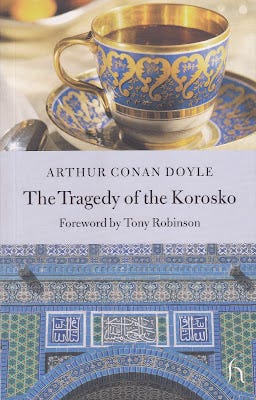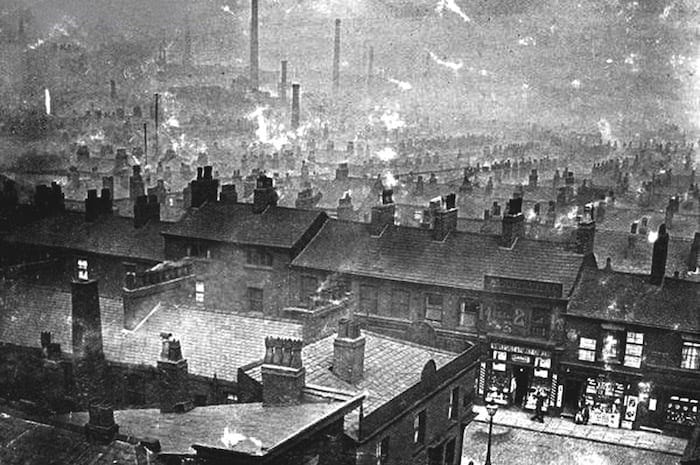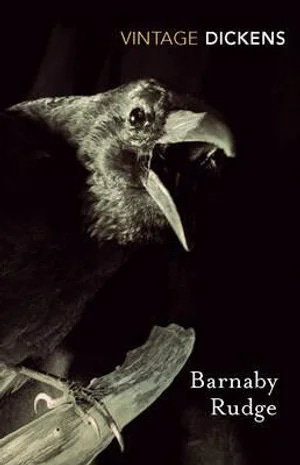Five Underrated Novels by Well-Known Authors
Sir Arthur Conan Doyle, Elizabeth Gaskell, Elizabeth von Arnim, Charles Dickens & Leo Tolstoy
Sir Arthur Conan Doyle - Sir Arthur Conan Doyle is best known for his Sherlock Holmes' detective character but he also wrote some excellent historical novels.
The White Company (1891) and its 'prequel' Sir Nigel published in 1906, are two that are set during The Hundred Years' War and are fairly well-known, but I stumbled upon one of his books that I’d never heard of and may have passed it up if I hadn’t been attracted by the cover.
Arthur Conan Doyle was born in Edinburgh in 1859. After finishing school he went on to study medicine and later moved to the south of England to set up a medical practice. It was here that he started to focus on his writing and where he met his future wife, Louise. About nine years after their marriage, the couple moved to Egypt in hopes of overcoming Louise's poor health, but she died of tuberculosis six years later.
While in Egypt, Conan Doyle witnessed firsthand the fragility of British rule in the Middle East and the idea for this book was born.
In 1895 the steamer, S.W. Korosko, set out from Shellal, a small village in Upper Egypt, with an assorted group of English, Irish and American tourists on board. Their intention was to travel up the two hundred miles of Nubian Nile, visiting the various points of interest along the way, but during one of their excursions they were kidnapped by a group of Arab dervishes and plunged into a world steeped in seventh century ideas and practice.
And now they were herded in at the base of the Abousir rock, this little group of modern types who had fallen into the rough clutch of the seventh century - for in all save the rifles in their hands there was nothing to distinguish these men from the desert warriors who first carried the crescent flag out of Arabia. The East does not change, and the dervish raiders were not less brave, less cruel, or less fanatical than their forebears.
The Tragedy of the Korosko is an absorbing adventure that, despite being published over a hundred years ago, is uncannily relevant to us in the 21st Century. It has its moments of melodrama, an improbable optimistic ending, and the colonial attitude is downright embarrassing and arrogant at times, but it is historically real. Apart from the cultural and historical aspects, which are fascinating, the author's humour is cleverly scattered throughout and his characters sensitively depicted.
Miss Adams, the Bostonian old maid:
She had never been from home before, and she was now busy upon the self-imposed task of bringing the East up to the standard of Massachusetts. She had hardly landed in Egypt before she realised that the country needed putting to rights, and since the conviction struck her she had been very fully occupied. The saddle-galled donkeys, the starved pariah dogs, the flies round the eyes of the babies, the naked children, the importunate beggars, the ragged, untidy women - they were all challenges to her conscience, and she plunged in bravely at her work of reformation. As she could not speak a word of the language, however, and was unable to make any of the delinquents understand what it was she wanted, her passage up the Nile left the immemorial East very much as she had found it...
The English bachelor:
His work had become an ingrained habit, and, being a bachelor, he had hardly an interest in life to draw him away from it, so that his soul was being gradually bricked up like the body of a medieval nun. But at last there came this kindly illness, and Nature hustled James Stephens out of his groove, and sent him into the broad world...
At first he resented it deeply. Everything seemed trivial to him compared to his own petty routine. But gradually his eyes were opened, and he began dimly to see that it was his work which was trivial when compared to this wonderful, varied, inexplicable world of which he was so ignorant.
The British colonel:
He rode with his back arched and his chin sunk upon his breast, for the old, time-rotted body was worn out, but in his bright, alert eyes there was always a trace of the gallant tenant who lived in the shattered house.
Elizabeth von Arnim - The Enchanted April (1922) is probably von Arnim’s best known novel. I discovered her around the same time as I did Edith Wharton and both authors have gotten under my skin with their beautiful literary writing and their sensitive treatment of women’s issues and sometimes difficult themes. In the context of the times in which they lived, (they were both born in the 1860’s) they explored subjects that tended to be either avoided or were taboo.
Love (1925) explores attitudes to marriage, ageing, and the complexity of family dynamics.
Catherine Cumfrit had been married to a much older man and was a widow for twelve years after his death before she met 25-year-old Christopher in the stalls of a London theatre. A friendship ensued and developed into romance. Catherine had a 19-year-old daughter, Virginia, who married a man a little older than Catherine herself. He had been waiting for Virginia to come of age for years and snapped her up as soon as she did. They were quite happy together and Virginia was expecting their first child.
Von Arnim contrasts the societal attitudes to both couples and does so with perception and humour, highlighting the obvious hypocrisy where a man could marry a much younger woman and nobody thought twice about it whereas that wasn’t the case if the situation were reversed. Witty and poignant in places, this was an interesting and delightful story.
Laughter – one of the most precious of God’s gifts; the very salt, the very light, the very fresh air of life; the divine disinfectant, the heavenly purge. Could one ever be real friends with somebody one didn’t laugh with? Of course one couldn’t.
Elizabeth Gaskell - North & South, Cranford & Wives and Daughters are Gaskell’s well-loved novels, and for good reasons! Mary Barton: A Tale of Manchester Life (1848) was Gaskell’s first novel. It is the story of working-class poverty in the industrial city of Manchester during the early to mid 1800’s. In the preface she writes:
‘Three years ago I became anxious (from circumstances that need not be more fully alluded to) to employ myself in writing a work of fiction.’
The circumstances she referred to was the death of her infant son from Scarlet Fever and her husband’s encouragement to turn to writing to distract her from her grief as she’d previously had some work published in a magazine. And so out of her own grief comes this powerful first-hand account of the poverty-stricken inhabitants of Manchester, the first Industrial City.
There are some similarities to North and South which was published about six years later – the agitations between the factory workers and the mill owners, the setting of industrial Manchester where Gaskell herself lived, and a romance – but Mary Barton is much bleaker and focuses on the plight of the working class during the depressed times of the ‘hungry forties.’
Mary’s life starts off quite well, with her father, John, in work and the family reasonably provided for, but tragedy enters their lives when Aunt Esther, her mother’s sister, disappears. The shock contributes to the death of Mary’s mother and with her death, John Barton’s life takes a downward turn.
‘One of the good influences over John Barton’s life had departed that night. One of the ties which bound him down to the gentle humanities of earth was loosened, and henceforward the neighbours all remarked he was a changed man. His gloom and his sternness became habitual instead of occasional.’
Mary, who is a real beauty, catches the eye of the son of a rich mill owner and he pursues her. She is so caught up with the idea of a better life and becoming a lady that she spurns her childhood friend, Jem, who has his heart set on marrying her. The rich young man is infatuated with Mary but has no plans for marriage. This situation echoes that of her Aunt Esther, although Mary does not yet know the circumstances of her Aunt’s disappearance.
Mrs Gaskell was a contemporary of Charles Dickens and tackled many of the same issues that he did. She was also a contemporary of Friedrich Engels (the co-author of The Communist Manifesto) who also wrote about the conditions of the working class during his 1842-1844 stay in Manchester.
The two authors had very different responses to the situation as may be seen in the story of Mary Barton.
As I mentioned earlier, Mary Barton is a bleak story. There are multiple deaths due to poverty, poor choices which lead to dire consequences, a murder mystery and a court-room scene. I was beginning to think everything was going to finish tragically, but it ended well. I thoroughly enjoyed this story and it kept me hooked throughout.
Charles Dickens - Barnaby Rudge was published in 1841 and was Charles Dickens’ first historical novel. It is his least read book, which surprised me as the story is very interesting. It is based on a real historical event and includes a murder mystery, a talking raven, two romantic dramas, as well as being a social commentary on mob rule – all of this is interspersed with characteristic episodes of Dickens-type humour.
The book’s subtitle, ‘A Tale of the Riots of ‘Eighty,’ refers to the Anti-Catholic (‘No Popery’) Riots of 1780 led by Lord George Gordon. The riots began peaceably enough when about 50,000 protesters marched to petition Parliament to revoke The Catholic Relief Act. This Act, which was passed in 1778, lifted restrictions on the civil rights of Roman Catholics.
Dickens vividly describes the degeneration of the march as troublemakers and anyone with an axe to grind about anything joined in, resulting in a week of rioting and basic anarchy which some historians consider to be the closest Britain has ever come to a fully-fledged revolution.
During the riot hundreds of people died; public buildings, including Newgate Prison, were burnt down; the Bank of England was attacked, chapels were destroyed and private homes belonging to Catholics were looted and burned.
It was not until King George III sent out around 15,000 troops, who shot dead nearly 300 of the rioters, that order was restored.
It is a neglected classic that deserves to be more widely read and is worth reading just for his depiction of the madness of crowds and the descent into mob rule, but there is also a memorable cast of characters. Yes, Dickens wrote other novels where the characters were more fully explored but Barnaby Rudge revolves around an historic event that absolutely appalled and shocked him. His only other historical novel was A Tale of Two Cities, which was set during the French Revolution and published eighteen years after Barnaby Rudge. The London riot of 1780 could have degenerated into something like what occurred in France in 1789–1799, an appalling thought for anyone.
Leo Tolstoy - Tolstoy is best known for War & Peace and Anna Karenina which are considered to be among the greatest novels ever written. He wrote many short stories that tend to be obscured by his epics and one that I think deserves particular mention is The Death of Ivan Ilich (1886).
Its 51 pages embodies a powerful and intense story that Tolstoy wrote when he was in his late fifties, almost a decade after his masterpiece, Anna Karenina. It is the story of a man whose main aim in life was to be comfortable, to enjoy life, and to be approved by society – and how this man had to come to terms with his own humanity.
His official pleasures lay in the gratification of his pride; his social pleasures lay in the gratification of his vanity.
Ivan Ilyich married well because that was agreeable to him and looked upon as the correct thing to do by those persons of higher standing. At first everything about his marriage fitted well with his ideas of a light-hearted and agreeable life, but when a new element arose to disturb his peace, he decided that he needed to free himself from the unpleasant aspects of domestic life. As a result he spent less time at home and poured himself into his office as a public prosecutor.
Ivan Ilyich rose in the world; the family moved in the best circles and everything carried on nicely. Even his marriage proved agreeable at times but he began to experience symptoms of the disease that was to take his life. The rest of the story so poignantly details Ilyich’s coming to terms with the truth of his condition, his loss of dignity as he is forced to accept the help of others, and most of all, the agony of knowing that everyone is acting falsely by not acknowledging that this disease is going to take his life.
For such a short book, this story packs a powerful punch. It lays bares the inner workings of a man whose life was shallow and self-promoting, his struggles between hope and despair, his anger as he thought of ‘all the correctness of his life,’ until finally he comes to the point where he asks himself, ‘Can it be that I have not lived as one ought?’







Of these five I’ve only read Mary Barton and Ivan Ilyich. I keep hearing The Enchanted April recommended; I’ll have to read it (and the other two!)